|
Notes: Aintree Central was ituated on the Cheshire Lines Railway’s (CLC) North Liverpool extension line that ran from Walton to Aintree. The line opened for Goods Traffic to Walton and to Aintree on the 1 December 1879. On the same date a passenger service was introduced between Walton on the Hill and Liverpool Central. The CLC was a joint railway company that was made up of three equal partners, the Great Northern Railway (GNR), the Manchester, Sheffield & Lincolnshire Railway (MSLR) and the Midland Railway (MR).
 |
The CLC opened a station at Aintree on the 13 July 1880 which they named Aintree Racecourse. As its first name might suggested it was very close to the famous Aintree Racecourse which was the home of the ‘Grand National’ race meet. When the station first opened it was effectively a terminus station at the northernmost end of the North Liverpool Extension |
line and it was used on race days only.
On the 1 September 1884 the Southport and Cheshire Lines Extension Railway (S&CLER) opened between Aintree and Southport Lord Street and to coincide with the opening the station was renamed as Aintree and regular public services commenced. The new line which ran from Aintree to Southport Lord Street was designed to give access to the lucrative holiday market at Southport as an alternative to the L&Y route. From the start of public services Aintree was served by trains from Liverpool Central and from Manchester Central the former following a circuitous route that could not hope to compete with the direct Liverpool Exchange to Southport Chapel Street Route. Although the S&CLER was nominally an independent company train services were operated throughout by the CLC or its constituent companies.
| Aintree Station was located on the south side of a road overbridge which carried Park Lane over the line on a sandstone bridge. It was a very short distance from the L&YR station that was also on Park Lane but on the north side. The L&YR station was also called Aintree. The station was provided with five platform faces four of which were located on two island platforms. The |
 |
platforms were numbered 1 to 5. Platform 1 was on the east side of the line and was constructed from brick, it served southbound trains. Platform 1 had the main booking facilities which were housed within a single storey wooden building. Access to the platform was via a sloping ramp that led up to Park Lane.
Platform’s 2 and 3 were located on a brick built island platform that was at the centre of the station complex. Platform 2 served northbound trains and 3 was used by excursions. Platforms 2 and 3 had a single storey timber built canopy that included basic waiting facilities and provided passengers with protection from the elements. Toilet facilities were also provided on this platform in the form of an Iron Urinal at the south end of the platform. A small wooden shed was located at the north end of the platform which was used by ticket collectors on race days. Access to platforms 2 and 3 was by a set of steps at the north end of the island platform which connected up to Park Lane.
 |
On the west side of the site was the other island platform which was numbered 4 and 5. This platform was made up from timber edges infilled with spoil and surfaced with cinders. Platforms 4 and 5 were provided purely for Race Day traffic and so no passenger facilities were provided. A wooden shed identical to the one on platforms 2 and 3 was located |
at the north end for use by ticket collectors on race days. Access was by a set of steps to Park Lane at the north end.
The generous provision of platforms for such a local station was due entirely to the very heavy race day traffic.
In December 1895 Aintree had ten weekday services to Southport Lord Street which departed at 7.57am, 9.45am, 10.54am, 1.47pm, 2.24pm, 4.56pm, 5.53pm, 6.12pm, 7.43pm and at 8.53pm. There were also three trains to Southport on Sundays. Eight weekday services departed for Liverpool Central at 8.00am, 9.03am, 11.04am, 2.58pm, 4.31pm, 6.03pm, 7.55pm and at 10pm. There were no direct services to Liverpool Central on Sundays. To Manchester central there were two weekday trains which departed at 1.28pm and at 8.29pm. There were three trains to Manchester on Sundays.
| On 1 July 1897 the MSLR changed its name to the Great Central Railway (GCR). By the end of the 19th Century Aintree Station was used by trains that had originated from all parts of the GCR, GNR and MR networks on the Grand National Race Day. Special timetables had to be drawn up to cope with the levels of traffic. All of the stations platforms would be |
 |
occupied by trains for most of the day.
The usual working practice was for trains to be hauled out of the station as soon as they had deposited their passengers. Locomotives would go to Walton on the Hill depot for servicing whilst the coaches were made ready for the return journeys later in the day.
The July 1922 timetable showed that Aintree still had ten weekday services to Southport Lord Street although the timings had altered slightly with the first departure leaving at 7.36am and the last at 9.24pm. Seven weekday services ran to Manchester Central at 8.09am, 8.44am, 10.07am, 12.49pm, 1.23pm, 6.00pm and 8.43pm. For Liverpool Central there were four trains at 8.17am, 9.18am, 3.44pm and 7.29pm. There were no Sunday services shown at this time.
 |
The line from Aintree to Southport was closed to passengers on the 1st January 1917 as a war time economy measure until the 1st April 1919. For a brief period Aintree reverted to being a terminus station but on the 1st April 1919 services resumed on the Southport line.
At the time of the ‘Grouping’ in 1923 the CLC |
remained as an independent company but its parent companies became the London & North Eastern Railway (LNER) who owned two thirds of the shares and the London Midland & Scottish Railway (LMS) who had the remaining third. By the 1920s the most common services ran between Manchester Central and Southport Lord Street.
The LMS timetable for 18 July 1932 to 11 September 1932 showed Aintree as having nine weekday services to Southport Lord Street at 7.39am, 10.52am, 11.18am, 12.07pm, 1.05pm, 4.06pm, 5.45pm, 7.14pm and 8.10pm. There were also two Sunday trains at 11.04am and 6.43pm. Seven trains went to Manchester Central at 8.00am, 8.45am, 10.41am, 1.19pm, 1.59pm, 3.59pm and 8.38pm. There was a Liverpool Central service at 5.59pm and three trains on Sundays for Manchester Central at 10.04am, 2.34pm and 8.16pm.
| The CLC became part of British Railways (London Midland Region) on the 1st of January 1948. They renamed the former CLC station as Aintree Central on 1st July 1950. The former S&CLER from Aintree to Southport had never really delivered the traffic levels that its promoters had hoped for. British Railways saw it as an unnecessary duplicate route and they withdrew |
 |
all passenger services from it on the 7th January 1952. Goods services followed six months later. Once again the Aintree Central station became a terminus but this time it would be for good. A sparse service operated between Aintree Central and Manchester Central which called at all stations along the route. A few peak hour services ran to Liverpool Central. Passengers wanting to travel to Liverpool Central had to change at Gatearce for most of the day. By September 1956 there were only three weekday departures from Aintree Central at 6.38am, 7.40am and 8.09am. The first two went to Manchester Central and the last to Warrington Central. There were four weekday arrivals at 2.24pm and 6.10pm from Liverpool Central, at 6.25pm from Manchester Central and at 6.44pm from Warrington Central. There were two additional arrivals on Saturdays at 1.07pm from warrington Central and 1.23pm from Manchester Central.
The situation was very different on race days when trains continued to run into the station from all over the Country.
On the 7th November 1960 all regular passenger services between Aintree Central and Gateacre were withdrawn. Officially the station remained open for race day traffic the last of which ran on the 26th of March 1966. The station had closed to freight traffic on the 7th of December 1964 except for a private service that ran to the Metal Box factory which was located to the north of the station.
 |
Sometime after 1965 the stations buildings were demolished and in 1969 the line through the station was closed and lifted. A short section of track was left in situ just to the north of the station until the early 1990s to serve the Metal Box factory which had a daily goods service until 1991. In the mid 1990s the site of Aintree Central was leveled and developed as an |
industrial estate.
Tickets by Michael Stewart, and Bradshaw by Nick Catford.
Sources:
- The Cheshire Lines Committee, by P Bolger, 1984, Heyday Publishing Company.
- Bradshaw Timetable December 1895.
- Bradshaw Timetable July 1922.
- LMS Timetable Summer 1932.
- BR (LMR) Timetable September 1956.
- The research notes of Tony Graham taken from the National Archives.
To see the other
stations on the CLC North Liverpool Extension Line click on the
station name: Warbreck,
Walton on the
Hill, Huskisson,
Clubmoor, West
Derby, Knotty Ash,
Childwall & Gateacre
For stations on
Southport & Cheshire Lines Extension Railway click on the
station name: Southport
Lord Street, Birkdale
Palace, Ainsdale Beach,
Woodvale, Mossbridge,
Altcar & Hillhouse, Lydiate &
Sefton and Maghull
|

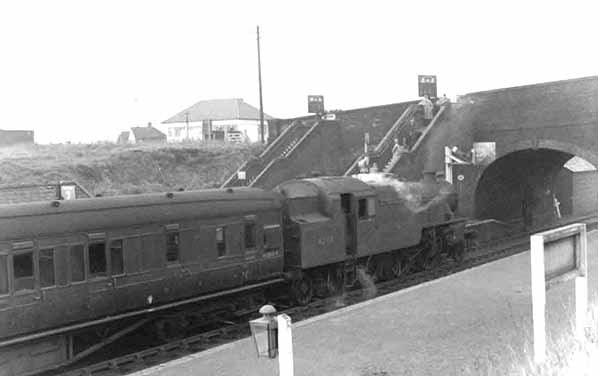
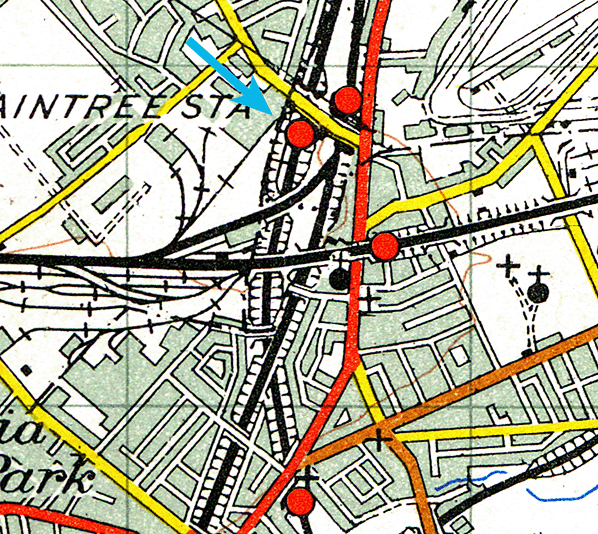
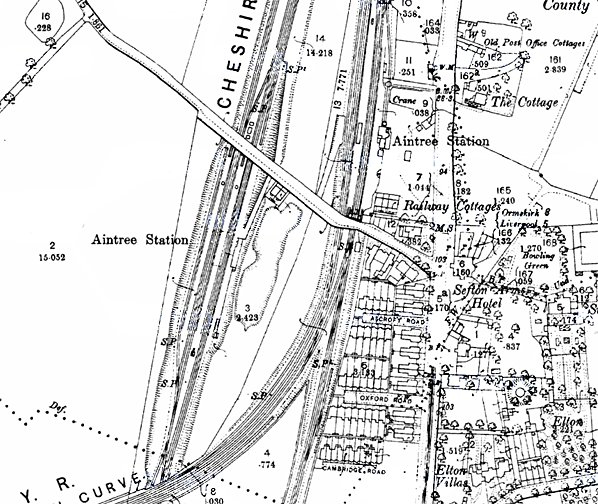
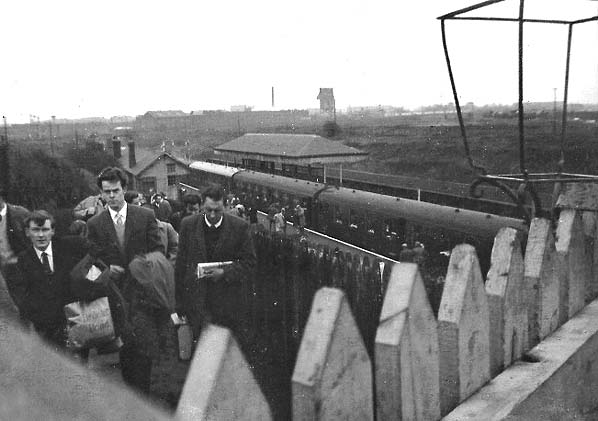
.jpg) Aintree Central after closure in June 1965. The station had been used earlier in the year for Grand National Day excusion trains. It was to be used only one more time in 1966.
Aintree Central after closure in June 1965. The station had been used earlier in the year for Grand National Day excusion trains. It was to be used only one more time in 1966.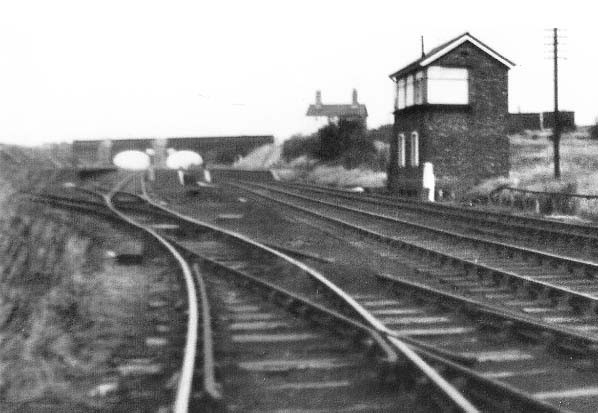 Looking north at Aintree Central station in September 1967. Regular passenger services had ceased in 1960 and the last Grand National excursions had run in the previous year.
Looking north at Aintree Central station in September 1967. Regular passenger services had ceased in 1960 and the last Grand National excursions had run in the previous year.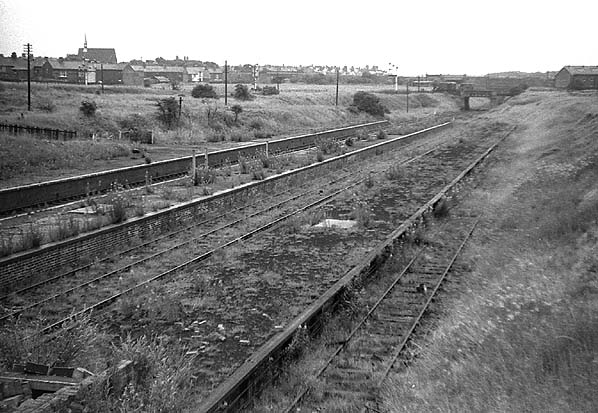
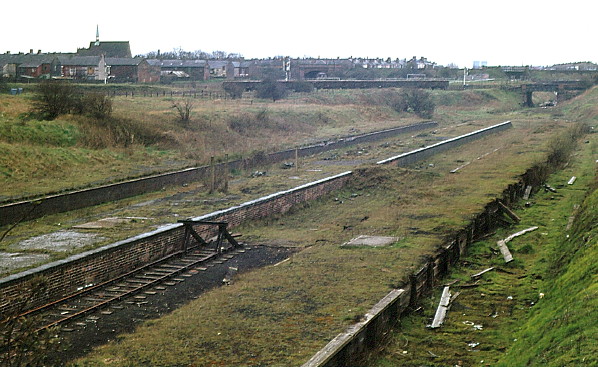
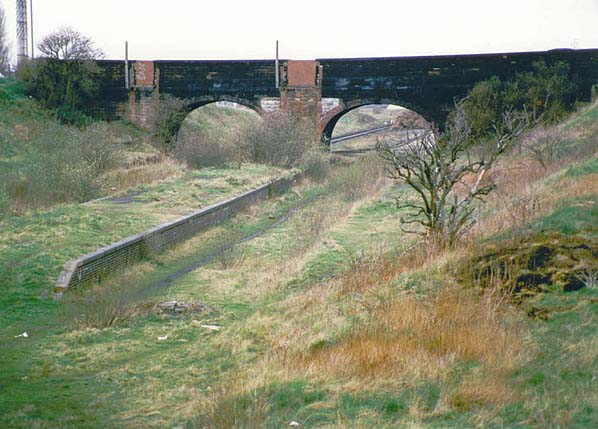
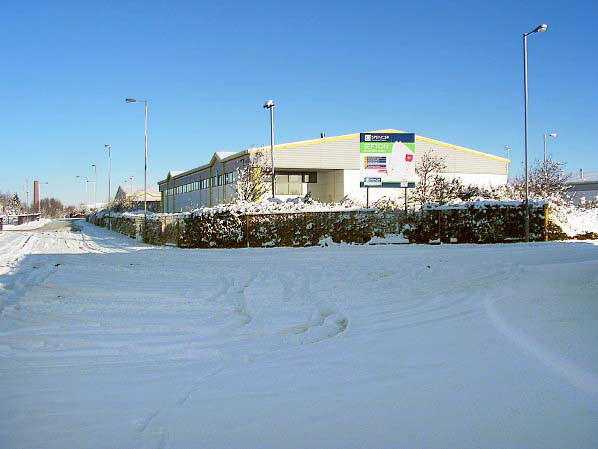 The site of Aintree Central looking north in December 2010.
The site of Aintree Central looking north in December 2010..jpg)
.jpg)
 Home Page
Home Page 

















